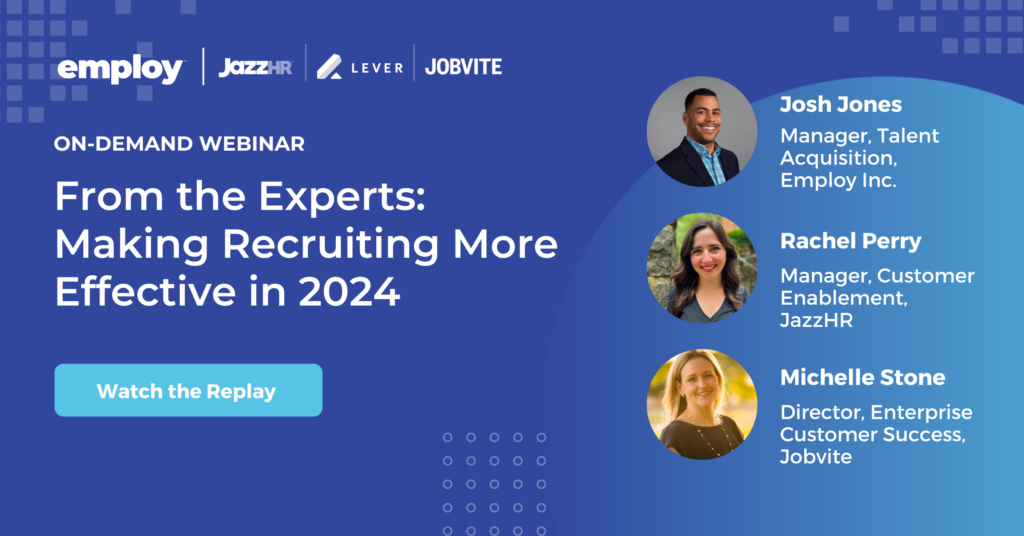Recruitment is evolving at breakneck speed. For companies of all sizes and recruiting complexities, navigating through the maze of hiring challenges and opportunities is more crucial than ever.
Learning from experts on how to make hiring more effective and efficient is essential within the current labor market. During the recent From the Experts: Making Recruiting More Effective in 2024 webinar, a panel of three talent practitioners discussed how to optimize recruiting strategies for this year. These panelists included:
- Josh Jones, Manager, Talent Acquisition, Employ Inc.
- Michelle Stone, Director, Enterprise Customer Success, Jobvite, an Employ Solution
- Rachel Perry, Manager, Customer Enablement, JazzHR, an Employ Solution
During this insightful session, each practitioner shared insights and innovative recruitment strategies to tackle the challenges encountered by recruiting professionals today.
Watch the full webinar on demand here.
How to Tackle Recruitment Challenges
The conversation centered on the difficulties facing talent acquisition professionals right now, focusing primarily on the scarcity of qualified candidates and the intense competition for talent.
Each panelist advocated for the need for faster, more efficient hiring processes, noting that recruiters must adapt to the evolving recruitment landscape and employ strategies to enhance and optimize their recruiting strategies.
To enhance efficiency, the role of technology and innovation is more important than ever. Recruitment technology, analytics, AI integration, and data-driven decision-making are not just buzzwords — they are principles that should be embraced by recruiting teams.

Strategies for Effective Recruiting
The driving force behind effective recruitment is efficient data-driven strategies. Panelists focused on two major strategies, including stakeholder feedback and developing candidate personas.
Michelle Stone highlighted the importance of aligning talent acquisition goals with the executive team and investing in existing employees for high-quality hires that already are dedicated to your organization.
Josh Jones provided valuable insights on creating candidate personas using feedback from candidates and recent hires. He recommended creating at least two candidate personas for each role and tailoring job descriptions accordingly, enhancing their appeal to potential candidates.
By segmenting candidate pools and tailoring engagement strategies to fit each audience, recruiting teams can build a framework and greatly improve their overall quality of hire. Rachel Perry further suggested researching competitors’ job descriptions to broaden understanding and improve approachability.
The Human Side of Hiring
The conversation also highlighted the personalized nature of experiences within recruitment.
Michelle Stone emphasized the significance of texts and emails as a more efficient candidate communication method. She also proposed segmenting candidates into key talent, strategic, and relationship audiences for effective audience engagement.
Josh Jones emphasized treating active and passive candidates differently, and indicated the importance of uniformity within interview teams, while Rachel Perry noted the importance of diversity, equity, and inclusion (DEI) in recruitment.
Harnessing the Right Recruitment Technology
The discussion concluded with the importance of recruiting analytics and metrics, harnessing purpose-built technology in recruiting, and providing a top-notch onboarding experience.
By highlighting strategies that can help companies adapt in the current hiring environment, the panelists provided actionable takeaways that companies can use to streamline and optimize their recruiting process.
Find out how to improve your hiring efforts — no matter what kind of roadblocks you face — and drive efficiencies in your recruiting function by optimizing strategies for the coming year. Watch the on-demand webinar now.


